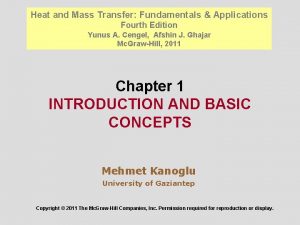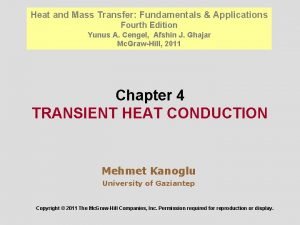Numerical study of heat and mass transfer during

- Slides: 1

Numerical study of heat and mass transfer during contact heating of potato slices T. Vine, D. Flick, B. Broyart UMR Ingénierie Procédés Aliments, Agro. Paris. Tech, INRA, Université Paris-Saclay, 91300, Massy, France INRODUCTION: Studies concerning the contact heating of food products remain relatively rare in the literature despite the importance of this mode of heat transfer in many industrial and domestic operations such as grilling or pan-frying. In this work, a 2 D mathematical model was developed and used to better understand heat and mass transfer during contact heating of a particular product, the potato. RESULTS: Simulated results are compared to experimental data obtained using the experimental device. Results are shown for a constant heating power of -2 -2 -2 3. 2 k. W. m , 6. 4 k. W. m and 9. 6 k. W. m with and without the presence of an oil layer below the product. With oil Without oil Figure 1. Experimental setup GOVERNING EQUATIONS: Given the high temperature of the heating surface, the formation and moving of a boiling front at the bottom surface of the product is assumed. This boiling front is described using a moving interface that divides the product in two regions: the moist region and the dry region (the crust). Free convection, radiation & water evaporation Figure 3. Simulated and experimental results. Temperature profiles at three locations in the product and water loss kinetics. z Free convection, radiation & water evaporation Moist region Boiling front: Crust r Contact heat transfer Vapour emission + Thermal conduction (no resistance) in the crust + water evaporation + heat balance equation Figure 4. Example of simulation results. Temperature and water content field obtained after 15 min of heating (3. 2 k. W. m-2 with oil). Figure 2. Governing equations • • • GEOMETRY & MODEL IMPLEMENTATION: COMSOL Multiphysics 5. 2 2 D axisymmetric geometry Coefficient Form PDE for the moist region Boundary ODE for the boiling front and the crust Deformed geometry for the moving interface Free triangular mesh (4268 elements) CONCLUSIONS: The model was validated by showing good agreements between measured and calculated values of product temperature and water loss. Experimental characterization of the structure of the crust (porosity, permeability) is planned to improve model accuracy (especially for high heating power). Excerpt from the Proceedings of the 2019 COMSOL Conference in Cambridge

